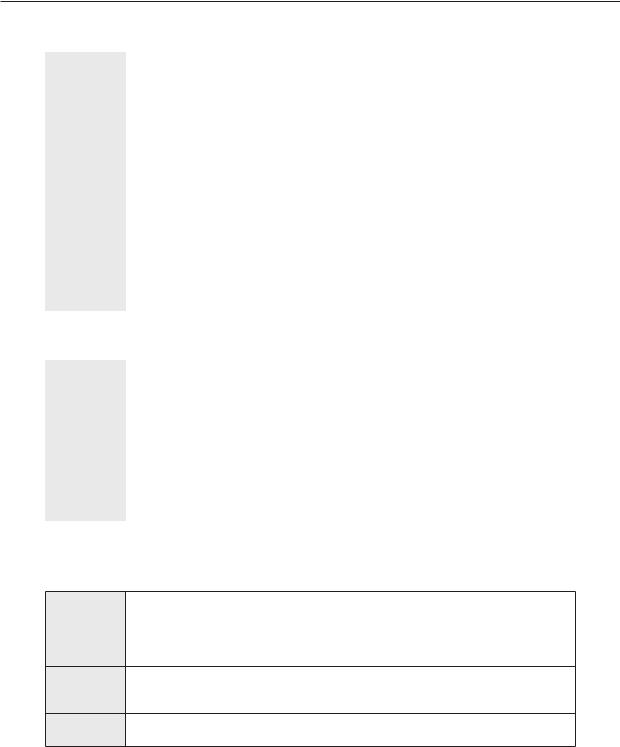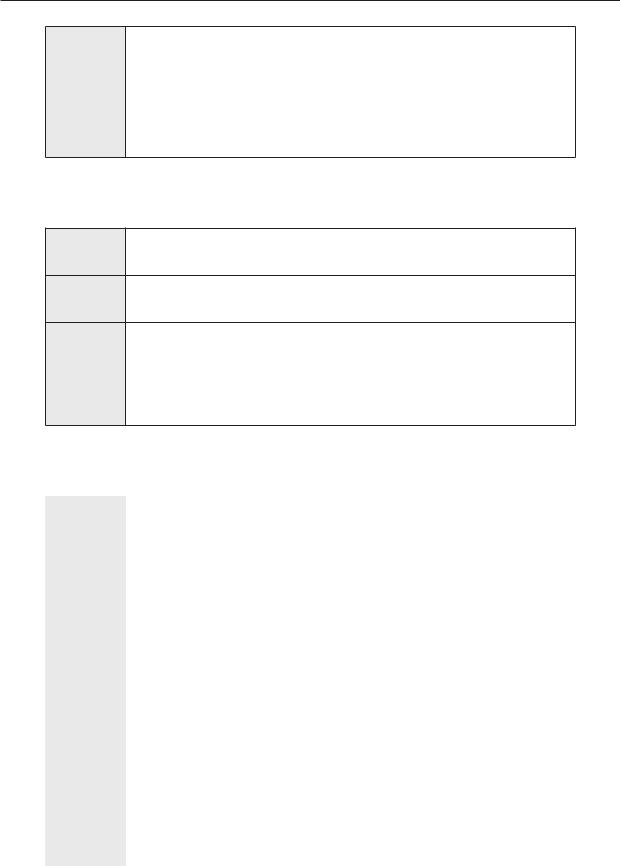
- •Table of contents
- •Abbreviations and Acronyms
- •Executive summary
- •Introduction
- •Institutional arrangements for tax administration
- •Key points
- •Introduction
- •The revenue body as an institution
- •The extent of revenue body autonomy
- •Scope of responsibilities of the revenue body
- •Special governance arrangements
- •Special institutional arrangements for dealing with taxpayers’ complaints
- •Bibliography
- •The organisation of revenue bodies
- •Getting organised to collect taxes
- •Office networks for tax administration
- •Large taxpayer operations
- •Managing the tax affairs of high net worth individuals taxpayers
- •Bibliography
- •Selected aspects of strategic management
- •Key points and observations
- •Managing for improved performance
- •Reporting revenue body performance
- •Summary observations
- •Managing and improving taxpayers’ compliance
- •Bibliography
- •Human resource management and tax administration
- •Key points
- •Aspects of HRM Strategy
- •Changes in policy in aspects of HRM within revenue bodies
- •Staff metrics: Staff numbers and attrition, age profiles and qualifications
- •Resources of national revenue bodies
- •Key points and observations
- •The resources of national revenue bodies
- •Impacts of recent Government decisions on revenue bodies’ budgets
- •Overall tax administration expenditure
- •Measures of relative costs of administration
- •International comparisons of administrative expenditure and staffing
- •Bibliography
- •Operational performance of revenue bodies
- •Key points and observations
- •Tax revenue collections
- •Refunds of taxes
- •Taxpayer service delivery
- •Are you being served? Revenue bodies’ use of service delivery standards
- •Tax verification activities
- •Tax disputes
- •Tax debts and their collection
- •Bibliography
- •The use of electronic services in tax administration
- •Key points
- •Provision and use of modern electronic services
- •Bibliography
- •Tax administration and tax intermediaries
- •Introduction
- •The population and work volumes of tax intermediaries
- •Regulation of tax intermediaries
- •The services and support provided to tax intermediaries
- •Bibliography
- •Legislated administrative frameworks for tax administration
- •Key findings and observations
- •Introduction
- •Taxpayers’ rights and charters
- •Access to tax rulings
- •Taxpayer registration
- •Collection and assessment of taxes
- •Administrative review
- •Enforced collection of unpaid taxes
- •Information and access powers
- •Tax offences (including policies for voluntary disclosures)
- •Bibliography

38 – 1. INSTITUTIONAL ARRANGEMENTS FOR TAX ADMINISTRATION
Special governance arrangements
Like all government bodies, revenue bodies are ultimately accountable to the citizens they serve. The framework within which this accountability operates varies between countries and is a result of many factors including the institutional arrangements and government structures in place. The following section identifies special/unusual governance mechanisms in place to ensure this accountability is achieved. It focuses on examples of the oversight mechanisms in place in selected revenue bodies. Some approaches for achieving improved accountability for performance are covered in Chapter 3.
Formal management boards and advisory bodies
As indicated in Table 1.1, in 11 countries a management/advisory board or council has been interposed between the revenue body and the relevant minister/arm of government to provide a degree of independent advice on the plans and operations of the revenue body and tax administration arrangements in general.7 In all of the examples cited hereunder, the board’s membership includes non-revenue body officials. Whilst the specific functions of the boards vary between countries all execute an oversight function and/or would appear to have a role in strategy development and planning and the sign-off of formal business plans. Without exception, board members are not involved in issues concerning the tax affairs of individual taxpayers and do not have access to specific taxpayer information. For a number of the countries where this arrangement has been established, its introduction coincided with the establishment of a new more autonomous body for tax administration operations (e.g. in Argentina, Canada, Singapore and South Africa 8). A brief description of the set-up in selected countries is set out hereunder:
Argentina: Advisory Council for AFIP (Spanish acronym for name of revenue body)
Background |
The Advisory Council was established in the late 1990s with the creation of single agency |
|
(i.e. AFIP) to administer tax customs and social contributions collection |
Role |
The Council periodically evaluates and verifies the AFIP’s Management Plans that are |
|
submitted to the Chief Cabinet Minister. |
Composition |
The Council is made up of representatives from the different sectors of society, both public |
|
and private, among which are the Ministry of Economy and Production, the Central Bank of |
|
Argentina, the National House of Representatives and Senate, the National Social Security |
|
Administration, provincial government officials and renowned tax experts. |
Source: Integration of the Administration of Internal Taxes, Customs Duties and Social Security Contributions for the 41st Assembly of CIAT, Barbados.
Bulgaria’s National Revenue Agency Managing Board
Background The Managing Board was created in 2006, coinciding with the establishment of a new revenue body (i.e. the NRA) and in conjunction with its new responsibilities for the collection of social insurance contributions.
Role The Board considers and approves the NRA’s strategic plan, its draft budget, regular reports of performance, its annual report, decisions concerning the organisation and scope of activities of its headquarters and territorial structures, strategies for human resource, information systems development, buildings and facilities, decisions for writing off receivables, and issues of co-ordination and interaction with other key Government agencies.
TAX ADMINISTRATION 2013: COMPARATIVE INFORMATION ON OECD AND OTHER ADVANCED AND EMERGING ECONOMIES – © OECD 2013

1. INSTITUTIONAL ARRANGEMENTS FOR TAX ADMINISTRATION – 39
Composition The Managing Board is comprised of the Minister of Finance, the Governor of the National Social Security Institute, the Director of the National Health Insurance Fund, a deputy minister of finance appointed by the Minister of Finance, and the Executive Director of the NRA. The Minister chairs the Board.
Features of The Board settles its own working arrangements and decisions are adopted if two thirds its operation of its members (effectively four out of the five members) have voted in favour. Under the law established for its operation, the Board should meet at least once a month and there are formal requirements concerning the provision of meeting papers and the recording of
proceedings and decisions made.
Source: Law of National Revenue Agency (NRA).
|
Canada Revenue Agency (CRA) Board of Management |
|
|
Background |
The CRA’s Board of Management was established in 1998 with the creation of a new, |
|
more independent government agency-then known as the Canada Customs and Revenue |
|
Agency-to administer Canada’s tax and customs laws. |
Role |
The Board has the responsibility of overseeing the organisation and management of the |
|
CRA, including the development of the Corporate Business Plan, and the management of |
|
policies related to resources, services, property, personnel, and contracts. The Commissioner |
|
of the CRA, who is a member of the Board, is responsible for the CRA’s day-to-day |
|
operations. Unlike the boards of crown corporations, the Board is not involved in all business |
|
activities of the CRA. In particular, the Board has no authority in the administration and |
|
enforcement of legislation, for which the CRA remains fully accountable to the Minister of |
|
National Revenue. The Board is denied access to confidential client information. |
Composition |
The Board is comprised of 15 members appointed by the Governor in Council, 11 of who |
|
have been nominated by the provinces and territories. |
Features of |
To help the Board fulfil its governance responsibilities, committees have been established |
its operation |
to undertake much of the detailed review of items brought before the full Board for its |
|
consideration. The Audit, Governance, Human Resources, and Resources Committees |
|
apprise the Board of the items that fall within their scope and provide advice and make |
|
recommendations to the Board about these items. Each committee establishes an annual |
|
work plan to guide its activities in the upcoming fiscal year. |
|
The Audit Committee reviews the Agency’s accounting framework, financial and performance |
|
information, internal controls and financial risks, and compliance with financial and |
|
environmental legislation. The Governance Committee reviews all aspects of the Board’s |
|
governance framework to ensure that the Board functions in an effective and efficient |
|
manner that successfully supports the operations of the CRA. The Human Resources |
|
Committee reviews the management of human resources within the Agency and provides |
|
recommendations and advice on the Agency’s human resources management strategies, |
|
initiatives, and policies. The Resources Committee reviews the Agency’s operating and |
|
capital budgets and its capital investment plans, along with the development of administrative |
|
management strategies and policies for the management of funds, real property, contracts, |
|
equipment, information, information technology, and environmental obligations. |
|
A Board of Management “Oversight Framework (BoMOF) – Assessment of Performance” is |
|
an assessment of management performance conducted by the Board each year in areas of its |
|
oversight as per the Canada Revenue Agency Act. The Board is responsible for the oversight |
|
of the organisation and administration of the Agency and the management of its resources, |
|
services, property, personnel and contracts. The BoMOF, the results of which are made |
|
public, complements the Treasury Board Secretariat’s (TBS) Management Accountability |
|
Framework (MAF) and together the two assessment tools provide a complete evaluation |
|
of the Agency’s management performance. Both Frameworks are structured around key |
|
elements that establish expectations for good management. |
Source: Canada Revenue Agency website (June 2010).
TAX ADMINISTRATION 2013: COMPARATIVE INFORMATION ON OECD AND OTHER ADVANCED AND EMERGING ECONOMIES – © OECD 2013

40 – 1. INSTITUTIONAL ARRANGEMENTS FOR TAX ADMINISTRATION
Colombia’s National Tax and Customs Administration (DIAN)
Background |
The Management Board of DIAN was created in November 2011. |
Role |
The Board’s main responsibilities are to: a) advise the General Commissioner on tax, |
|
customs and foreign exchange administration policy matters; b) approve and to monitor |
|
DIAN’s business plan; c) evaluate progress reports presented by the General Commissioner |
|
and to put forth recommendations to improve performance; d) to approve the yearly budget; |
|
e) approve changes to the internal organisational design and staffing levels; and f) request |
|
for impact assessments of the initiatives which implementation require follow up according |
|
to the Board. |
Composition |
The Board has six members: the Minister of Finance, the General Tax Commissioner |
|
(DIAN), the head of the agency responsible for enforcing regulations regarding Social |
|
Security contributions (UGPP), and three independent members (experts with extensive |
|
experience in the areas of competence of DIAN) appointed by the Finance Minister |
Features of |
The Board reports to the national government through the Finance Minister. It meets once a |
its operation |
month. If an additional meeting is necessary, it can take place via Web conference. The decree |
|
that created the Board is posted online at: www.dian.gov.co/descargas/normatividad/2011/ |
|
Decreto_4171_03112011.pdf. Board proceedings are confidential and, therefore, not made |
|
public. Since its first official session in December 2011, it has met nine times (up to June 2012). |
|
Finland’s Tax Administration Advisory Board |
|
|
Background |
An Advisory Board was established by government Ordinance in 2002 and commenced |
|
operating in 2003. |
Role |
The role of the Board is to provide guidance/advice on strategic planning, tax administration |
|
priorities and operational guidelines. The Board convenes around six times per year. |
Composition |
The Board is comprised of a senior official of the Ministry of Finance, the Director- |
|
General of Tax Administration, and 6 members from local government, union, taxpayer |
|
and commerce bodies. |
Features of |
The Advisory Board met six times in 2012. The meetings addressed issues such as the |
its operation |
results of the job satisfaction survey and planning documents and monitoring reports related |
|
to operations and finances. |
Source: Revenue body’s annual report (various years).
Hong Kong Board of Inland Revenue
Role The Board of Inland Revenue is constituted under section 3 of the Inland Revenue Ordinance. Its role is to prescribe a) Returns to be used for property tax, salaries tax, profits tax and personal assessment or the form of the returns; b) Rates of annual allowance for depreciation on machinery and plant; and c) Procedures relating to applications for refunds and relief, appeals procedures, and, miscellaneous matters as authorised
Composition It has the Financial Secretary as its Chairman and 4 other appointed members, of which only one can be a Government official. Its Secretary is a Deputy Commissioner of Inland Revenue.
Features of The Board operates independently of the Inland Revenue Department. its operation
Source: Inland Revenue website.
TAX ADMINISTRATION 2013: COMPARATIVE INFORMATION ON OECD AND OTHER ADVANCED AND EMERGING ECONOMIES – © OECD 2013

|
|
1. INSTITUTIONAL ARRANGEMENTS FOR TAX ADMINISTRATION – 41 |
|
|
|
Mexico’s Governing Board for the SAT |
|
|
|
|
|
|
Background |
The creation of the Governing Board coincided with the establishment of a new more |
|
|
|
autonomous revenue and custom body in 1996. |
|
|
Role |
The Board’s roles are as follows: 1) assist in the development of fiscal policy and customs |
|
|
|
measures necessary for the development and implementation of the National Development |
|
|
|
Plan and sectoral programs; 2) provide opinions on draft bills, decrees, resolutions, |
|
|
|
administrative and general provisions in tax and customs matters; 3) approve programs |
|
|
|
and budgets of the SAT (i.e. the Tax Administration Service); 4) approve the basic |
|
|
|
organisational structure of the SAT; 5) consider and approve measures proposed by the |
|
|
|
chairman of the SAT to improve operational efficiency and taxpayer orientation; 6) approve |
|
|
|
the annual programme of continuous improvement for the SAT, including setting and |
|
|
|
monitoring targets for increased efficiency and improved taxpayer service delivery (NB: |
|
|
|
Descriptions of measures/performance indicators that must be used are set out in Chapter 3 |
|
|
|
of this series.); 7) analyse proposals for continuous improvement. |
|
|
Composition |
The Board consists of: 1) the Secretary of the Ministry of Finance and Public Credit, who |
|
|
|
will preside; 2) three directors selected by the Secretary of Finance from the employees of |
|
|
|
Finance; and 3) three independent directors appointed by the President of the Republic (two |
|
|
|
of whom must have been nominated by the national meeting of tax officials in the terms of |
|
|
|
the Fiscal Coordination Law). To be appointed, independent directors must not have held a |
|
|
|
federal or municipal government appointment in the prior year. Once appointed, they must |
|
|
|
not engage in tax or customs related-activities that are incompatible with their role and must |
|
|
|
attend 70% of convened meetings. |
|
|
Features of |
The Board is required to hold regular meetings, one at least every three months, and a |
|
|
its operation |
quorum requires at least 50% of members. Board decisions are made by majority vote, with |
|
|
|
the Secretary of Finance, as chair, having a casting vote in the event of a tie. |
|
Source: SAT’s website.
Malaysia’s Board of Management for Inland Revenue
Background The IRBM was established in March 1996 in accordance with the Inland Revenue Board of Malaysia Act 1995 to give it more autonomy especially in financial and personnel management as well as to improve the quality and effectiveness of direct taxes tax administration. A Board of external members was also created at this time.
Role The Board ensures that the Government’s interests are upheld, and that decisions for implementation by the management of IRBM are in line with Government aspirations. The Board is supported by several committees: 1) Internal Audit: 2) Finance; 3) Procurement; 4) Establishment; 5) Disciplinary; and 6) Appeal.
Composition IRBM is regulated by the following Board Members: a) The Secretary General of Malaysian Treasury who is the IRBM Chairman; b) Attorney General or its representative; c) Director General of Public Services or its representative; d) Not more than two other persons representing the Government, who are appointed by the Finance Minister; and e) Not more than two other persons appointed by the Finance Minister from the private sector.
Features of Board members meet regularly throughout each fiscal year (e.g. six times in 2010). its operation
Source: Revenue body’s website.
TAX ADMINISTRATION 2013: COMPARATIVE INFORMATION ON OECD AND OTHER ADVANCED AND EMERGING ECONOMIES – © OECD 2013

42 – 1. INSTITUTIONAL ARRANGEMENTS FOR TAX ADMINISTRATION
Board of the Inland Revenue Authority of Singapore (IRAS)
Background |
The IRAS Board was established in 1992, as part of legislation authorizing the creation of |
|
a new statutory authority with autonomy in managing its operations to administer the tax |
|
laws. |
Role |
The Board is responsible for ensuring that the IRAS carries out its functions competently, |
|
and meets three times a year to review major corporate policies and approve financial |
|
statements, the annual budget and major expenditure projects. |
Composition |
The Board comprises the chairman who is also the Permanent Secretary of the Ministry |
|
of Finance, the Commissioner of Inland Revenue, and seven other members (comprising |
|
public and private sector representatives). |
Features of |
The Board has established three committees-the Audit Committee, the Staff Committee A |
its operation |
and the Investment Committee-to assist in carrying out its duties. The Audit Committee |
|
reviews and ensures that IRAS” accounting and financial policies and internal controls |
|
are in place, adequate and adhered to. The Committee works closely with the external |
|
auditor, the Auditor-General, to review the financial statements of IRAS, the scope of |
|
audit plans and the audit results. The Committee also reviews the annual audit plan of the |
|
Internal Audit Branch and the results of its work. The Staff Committee A is the approving |
|
authority for key remuneration policies in IRAS as well as key appointments, promotion |
|
and remuneration of senior executives in IRAS. The Investment Committee sets investment |
|
policies and guidelines and manages surplus funds available for investments. |
Source: Revenue body’s website.
South Africa Revenue Service’s external governance framework
Background |
The South African Revenue Service is an administratively autonomous organ of the state: |
|
it is outside the public service, but within the public administration. So although South |
|
Africa’s tax regime is set by the National Treasury, it is managed by SARS. |
|
The external governance framework is provided for by: |
|
The Public Finance Management Act 1 of 1999; |
|
The South African Revenue Service Act 34 of 1997; |
|
Specialist advisory committees which advise the Commissioner and the Minister of |
|
Finance on any matter concerning the management of SARS resources; and |
|
The Audit Committee which oversees the effectiveness of internal controls. |
|
|
Role |
1. Audit Committee: This committee must, among other things, review the effectiveness of |
|
the internal control systems in SARS; the effectiveness of internal audit; the risk areas of |
|
SARS operations to be covered in the scope of internal and external audits; the adequacy, |
|
reliability and accuracy of financial information provided to management and other |
|
users of such information; any accounting and auditing concerns identified as a result |
|
of internal and external audits; SARS compliance with legal and regulatory provisions, |
|
the activities of the internal audit function (including its annual work programme), |
|
co-ordination with the Auditor-General, the reports of significant investigations and |
|
the responses of management to specific recommendations; and where relevant, the |
|
independence and objectivity of the external auditors (not applicable to SARS). It must |
|
report and make recommendations to the Commissioner, report on the effectiveness of |
|
internal controls in the annual report of SARS and comment on its evaluation of the |
|
financial statements in the annual report. |
|
2. Specialist Advisory Committees: Human Resources, Operations, Customs, Procurement, |
|
Finance, Legal and Policy. |
TAX ADMINISTRATION 2013: COMPARATIVE INFORMATION ON OECD AND OTHER ADVANCED AND EMERGING ECONOMIES – © OECD 2013

1. INSTITUTIONAL ARRANGEMENTS FOR TAX ADMINISTRATION – 43
Composition The chairperson of the Audit Committee: must be independent; must be knowledgeable of the status of the position; must have the requisite business, financial and leadership skills; and may not be the chairperson of the Executive Committee or a person who fulfils an executive function in SARS. The majority of the members of the Audit Committee shall consist of non-executive members appointed by the Executive Committee, although committee members may not all be members of the Executive Committee. The majority of persons serving on an Audit Committee must be financially literate. The executive authority (the Minister of Finance) must concur with any premature termination of services of a member of the Audit Committee.
Source: Revenue body’s website.
Swedish Tax Agency Advisory Council
Background The Council was created as part of broader public sector reforms when, from January 2008, the Swedish Tax Agency became an agency managed by a Director-General, who alone is responsible to the Government for the activities of the Agency.
Role The task of the Council is to exercise public control and give advice to the DirectorGeneral. The Council has no decision-making responsibilities. The Advisory Council of the Swedish Tax Agency meets six times a year.
Composition By the side of the Director-General there is now an Advisory Council that may have up to 12 members. The members of the Council are appointed by the Government for a period of three years. In the current Advisory Council of the Tax Agency there are 9 members including the Director-General who is the chairman, academics with backgrounds in economics and/ or finance, representatives of industry and commerce, information technology consultants, the Deputy Director-General of another large Government agency, and some members of parliament.
Source: Inquiries with revenue body.
United Kingdom: The Board of Her Majesty’s Revenue and Customs (HMRC)
Background |
Legislation to create HMRC in 2005 included provision for the creation of a Board, to be |
|
comprised of members of HMRC’s internal Executive Committee and (four) non-executive |
|
(external) board members. In 2008, HMRC implemented a new governance structure |
|
appointing a non-executive Chairman and a new Chief Executive. The Chairman and the |
|
Board are responsible for the effective governance of HMRC. The Chief Executive and |
|
Executive Committee are responsible for running HMRC. |
Role |
The Board sits for a minimum of ten times a year and is chaired by the HMRC Chairman. |
|
The Board is supported by the Audit and Risk, Ethics and Responsibilities and People sub- |
|
committees and has the following responsibilities: 1) Development and final approval of |
|
HMRC’s overall strategy; 2) Development and final approval of HMRC’s communications |
|
strategy and sign off of significant HMRC communications identified within it; |
|
3) Development and final approval of the culture and values objectives and strategies; |
|
4) Approval of the final sub-strategies of lines of business and functions; 5) Approval of |
|
final business plans (incl. the annual financial plan); and 6) Advise the Chief Executive on |
|
the appointment of senior executives. |
|
Ensuring the strength of the top team by participating in the appointment of and advising |
|
on the ongoing competence of Board members, Executive Committee members and other |
|
key appointments. |
Composition |
The Board’s membership currently comprises the Chair, the Chief Executive, the Permanent |
|
Secretary of Tax, eight executive HMRC officials and six non-executive directors. Non- |
|
executive directors are senior business figures from outside the department who bring |
|
a diverse mix of expertise and skills from across both public and private sector. HMRC |
|
looks to its Non-Executive Directors to bring guidance and advice, support and challenge |
|
management about the department’s strategic direction, and provide support in monitoring |
|
and reviewing progress. |
TAX ADMINISTRATION 2013: COMPARATIVE INFORMATION ON OECD AND OTHER ADVANCED AND EMERGING ECONOMIES – © OECD 2013

44 – 1. INSTITUTIONAL ARRANGEMENTS FOR TAX ADMINISTRATION
Features of |
In approving the strategies and plans, the Board ensures that the views of HMRC’s |
its operation |
stakeholders are taken into account. It also periodically reviews the work of the three sub- |
|
committees to assure the highest standards of corporate governance are in place. Brief |
|
minutes of the Board’s proceedings are published regularly on HMRC’s website. |
|
There are very clear accountabilities for the Chairman and the Chief Executive. Setting |
|
the strategic direction and ensuring the highest standards of governance lies with the |
|
Chairman. The responsibility for delivery and expenditure lies with the Chief Executive. |
|
The top team is further strengthened by the appointment of a Permanent Secretary for Tax |
|
who is the senior tax professional in HMRC and also the Deputy Chief Executive. |
Source: Revenue body’s website.
United States: Internal Revenue Service’s Oversight Board
Background A nine-member IRS Oversight Board was created by Congress under the IRS Restructuring and Reform Act of 1998.
Role The Board’s responsibility is to oversee the IRS in its administration, management, conduct, direction, and supervision of the execution and application of the internal revenue laws. The Board was created to provide long-term focus and specific expertise in guiding the IRS so it may best serve the public and meet the needs of taxpayers.
Composition Seven board members are appointed by the President and confirmed by the Senate for five-year terms. These members have professional experience or expertise in key business and tax administration areas. Of the seven, one must be a full-time federal employee or a representative of IRS employees. The Secretary of Treasury and the Commissioner of Internal Revenue are also members of the Board.
Features of The Board operates much like a corporate board of directors, but is tailored to fit a public its operation sector organisation. The Board provides the IRS with long-term guidance and direction, and applies its private-sector experience and expertise in evaluating the IRS’s progress in improving its service. It reviews and approves IRS strategic plans and its budget requests, and evaluates IRS efforts to monitor its own performance. The Board reviews the hiring and compensation of senior IRS officials. It also recommends candidates to the President to
serve as IRS commissioner, and can recommend a commissioner’s removal.
The Board reaches out to a wide variety of stakeholders to understand their views on tax administration and its impact on taxpayers. The Board interacts regularly with external groups that include tax professionals, taxpayer advocacy groups, representatives of state tax departments, IRS advisory committees, IRS employees, the National Treasury Employees Union, and other groups that have an interest in tax administration. The Board also conducts an annual survey of taxpayers’ attitudes about compliance and other issues relating to tax administration.
The Board meets in sessions every other month, and holds at least one public meeting each year. The Board’s web site provides information on upcoming public meetings. The Board publishes an annual report (see www.ustreas.gov/irsob/board-reports.shtml), as well as a report reviewing the progress of IRS” electronic tax filing efforts. The Board may also publish interim reports throughout the year on specific topics, such as the budget. All reports are available on the Board’s web site. The Board also is invited to testify before Congress periodically. The Board’s testimony is posted on its web site. The Board distributes press releases describing its activities to the media at the end of each of its meetings.
Under the law, the Board cannot be involved in specific law enforcement activities, including audits, collection activities, or criminal investigations. It also cannot be involved in specific procurement activities or most personnel matters and it does not develop or formulate tax policy on existing or proposed tax laws.
Source: Oversight Board’s website.
TAX ADMINISTRATION 2013: COMPARATIVE INFORMATION ON OECD AND OTHER ADVANCED AND EMERGING ECONOMIES – © OECD 2013

1. INSTITUTIONAL ARRANGEMENTS FOR TAX ADMINISTRATION – 45
External/independent oversight of the tax administration system
Governments in Australia and the United States have established special bodies independent of the revenue body to report on the workings of the tax system, in particular, on aspects of tax administration. These bodies operate separately and independently of the national audit bodies in these two countries that oversee the workings of all government agencies. A brief description of these arrangements is set out hereunder:
|
Australia: Inspector-General of Taxation |
|
|
Background |
The Inspector-General of Taxation (IGT) was established as an independent statutory |
|
agency in 2003. |
Role |
The IGT’s role is to review: 1) systems established by the Australian Taxation Office (ATO) |
|
to administer the tax laws; and 2) systems established by tax laws in relation to administrative |
|
matters; for the purpose of reporting and making recommendations to Government on how |
|
those systems could be improved. The Act precludes the IGT from reviewing the imposition |
|
of taxes and tax rates, and the eligibility criteria for, or levels of, any rebates or grants |
|
administered by the ATO. |
|
The IGT seeks to improve the administration of the tax laws for the benefit of all taxpayers. |
|
Individuals and/or groups of taxpayers, professional associations and businesses are welcome |
|
to bring systemic administration issues to the attention of the IGT. The IGT endeavours to |
|
address taxpayers’ concerns on defective administration while ensuring resources of the |
|
agency are directed to those areas of most benefit to taxpayers overall. The overall aim |
|
is to identify how to reduce the administrative burden for taxpayers in meeting their tax |
|
obligations. |
Features of |
While a number of Commonwealth Government agencies examine systemic taxation |
operation |
administration matters, the IGT is the only agency with sole responsibility for such reviews. To |
|
ensure that reviews undertaken reflect areas of key concern, and to avoid duplication with other |
|
agencies, the Inspector-General develops the work programme following consultation with: |
|
1) taxpayers and their representatives; 2) Ombudsman; 3) Auditor-General; 4) Commissioner |
|
of Taxation; and 5) The Secretary of the Commonwealth Treasury. In conducting reviews the |
|
IGT may invite submissions and/or request/require the tax officials to provide information and |
|
documentation. The Act contains specific provisions on the confidentiality of submissions |
|
made to the Inspector-General. On completion of a review the Inspector-General reports |
|
directly to Government. All reports are subsequently made available within the timeframe |
|
outlined in the Act. The IGT provides an annual report to parliament on its operations. |
Examples of |
Review into the ATO’s administration of class rulings. |
studies in 2012 |
Review into the ATO’s small and medium enterprise audit and risk review policies, |
|
procedures and practices. |
|
Review into the Australian Taxation Office’s use of early and Alternative Dispute Resolution. |
United States: Treasury Inspector General for Tax Administration
Background |
The Treasury Inspector General for Tax Administration (TIGTA) was established in January |
|
1999 in accordance with the Internal Revenue Service Restructuring and Reform Act of 1998 |
|
(RRA 98). As mandated by RRA 98, TIGTA assumed most of the responsibilities of the |
|
IRS” former Inspection Service. |
Role |
Its role is to provide independent oversight of Internal Revenue Service (IRS) activities. |
TAX ADMINISTRATION 2013: COMPARATIVE INFORMATION ON OECD AND OTHER ADVANCED AND EMERGING ECONOMIES – © OECD 2013
